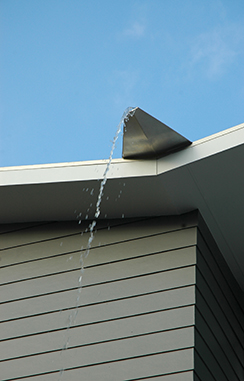- Products
- Industries
- Project Gallery
- Resource Center
- Metal Institute
- Services
- Shop
- Contact Us
May 5, 2016
by Amy Crenan
 There are a number of reasons why metal roofs are sustainable. The most obvious reasons are that they’re long-lasting and durable, recyclable, and they’re a natural pairing with roof-mounted photovoltaic (PV) systems for alternative energy. A metal roof is like the Swiss Army knife of sustainable architectural products because of its versatile environmental benefits.
There are a number of reasons why metal roofs are sustainable. The most obvious reasons are that they’re long-lasting and durable, recyclable, and they’re a natural pairing with roof-mounted photovoltaic (PV) systems for alternative energy. A metal roof is like the Swiss Army knife of sustainable architectural products because of its versatile environmental benefits.
Conserve Water with Metal Roofing
Yet, one of the more important environmental benefits that sometimes gets overshadowed by these other qualities is a metal roof’s capacity for water conservation.
Many cities in the U.S. encourage water conservation in one form or another. Such practices come in handy during extended water scarcity, like the one California has experienced for the past few years (if not longer, depending on one’s definition of “scarcity”).
Other places have the opposite problem. Flooding has most recently occurred in the Houston area, but is also a continuous problem in places like New York City, New Jersey and others. These flooding problems stem from unusually large amounts of rainfall, obviously, but also from the built environment’s inability to cope with rainfall because of the impermeable nature of surfaces in cities.
A metal roof can help when coupled with a storage device that captures the water and delays when it’s sent from the site into the city’s stormwater system. That captured water can be reused onsite for non-potable purposes, such as landscaping and toilet flushing.
The benefits to capturing and delaying the release of rainwater don’t just end with helping a city to better manage rainfall for drought or flooding conditions—stormwater retention also helps a building owner’s checkbook.
Reusing rainwater means paying less for water that the local water utility has had to treat and send into the building. Owners can save some cash on their water bills while simultaneously easing some stress on the utility. It’s win-win.
If you’re familiar with the phrase “they get you coming and going,” well, municipalities are similar with water supplies. Sure, they charge for providing a facility with water, but many also charge to remove water in what’s called a stormwater fee. If that fee is calculated by the amount of water leaving the site (quantity), then reducing the amount exiting via the municipal system will again save the owner money.
Metal roofs with water collection systems aren’t going to miraculously solve all flooding and drought concerns, but every little bit helps. Sustainability strives to meet the triple bottom line of people, planet, and profit—and metal roofs have the capacity to meet all facets of the triple bottom line for more than what typically gets talked about. So, once you know the client’s goals and concerns on your next project, be sure to have a conversation of your own to find out how a metal roof can help achieve the client’s vision.